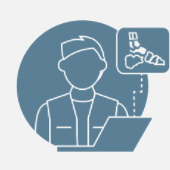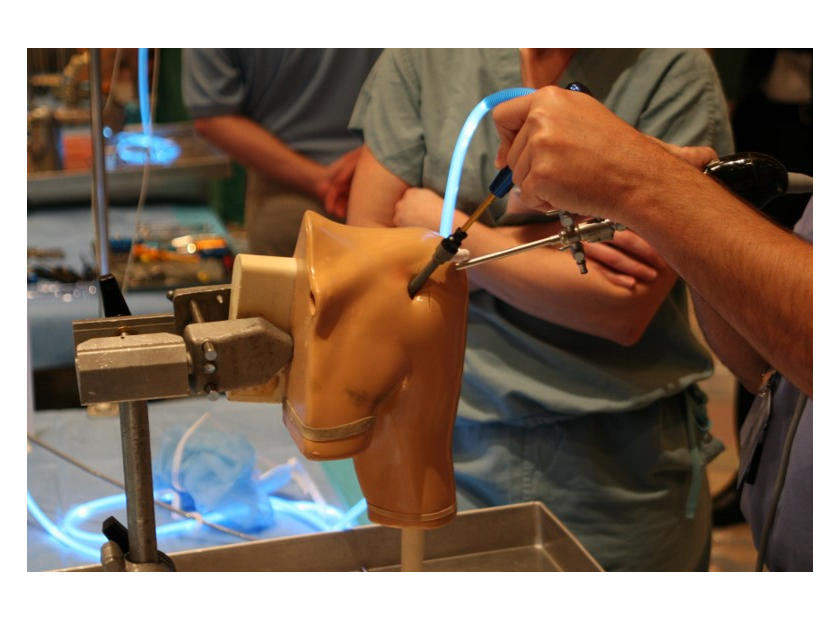Why Shoulder Arthroscopy Training Models Result in Improved Operating Room Performance
The shoulder offers some of the most complex arthroscopy challenges surgical residents will face. Every arthroscopy procedure requires mastery of a new set of psychomotor skills, but the complex anatomical construction of the shoulder—coupled with the tight spaces that have to be navigated—can make it particularly frustrating. The obstructed camera views mean successful outcomes depend on a mix of perfect knowledge, precision movements, timely reactions, and improvisation.
Those pressures make it problematic for novices to learn their craft in the operating room itself. As a result, the competencies of the next generation of orthopaedic practitioners is better earned through simulation models. Fortunately, research suggests that an increasingly sophisticated set of shoulder arthroscopy training models is up to the task of preparing future shoulder specialists.
“See One, Do One” No More
The benefits of arthroscopy are well worth the steep learning curve practitioners must overcome. The key-hole approach results in shorter recovery times, reduced risk of infection, and the fact that operations can be completed in an outpatient setting.
The traditional educational path to accessing those advantages is no longer able to cope with demand. Research shows that the “see one, do one, teach one” method of practitioner-led instruction is too time- and resource-heavy to remain effective. Furthermore, the availability, cost, and drawbacks of cadaveric simulation—such as inaccurate blood pressure and fluid distension factors—limit its appeal.
In place of those prevailing techniques have risen a new generation of engineered shoulder arthroscopy training models that offer a range of financial and institutional advantages. These models are proving their worth in transferring non-clinical skills to the operating room.
Confidence, Familiarity, and Outcomes
The aging Baby Boomer population is putting pressure on US medical institutions to graduate increasing numbers of shoulder specialists. More than 53,000 people now receive shoulder replacement surgery each year, and the figure is growing as the nation ages. To increase the exposure of young doctors to the complexities of shoulder arthroscopy, instructors are using increasingly sophisticated engineered shoulder models.
These models are more accessible and reusable than cadaveric models, more affordable and tactile than wholly computer models, and offer unique features such as scalable and adjustable complexity, radiopaque features, and haptic feedback that hones technique under pressure.
These models can be adapted to mimic both diagnostic and surgical procedures, including the core orthopaedic competencies of meniscectomy, tissue debridement, rotator cuff repair, and Bankart repair.
Designed to introduce confidence and operative familiarity in students as well as a range of technical skills, engineered models are increasingly proving their value.
Research Suggests Success
A study recently published in the Journal of Bone and Joint Surgery reveals the practical efficiency of simulated models in transferring skills from non-clinical to operating room settings.
The research argues that the use of simulation models will eventually replace cadaveric and clinical-heavy approaches. It compiled evidence from dozens of model studies and found that 95% of them showed an improvement in arthroscopic performance among students after using a simulation model.
Findings included:
- Students using a Sawbones ankle arthroscopic training benchtop model outperformed expectations in a 15-point diagnostic anatomic test.
- Similar enhanced performance and a reduction in errors was recorded using the FAST model of scaled arthroscope instruction.
- Positive intra-operative improvements were recorded using Sawbones dry arthroscopic training benchtop model, and the Sawbones and low fidelity cigar box arthroscopy model.
If similar shoulder arthroscopy training model solutions can be found to effectively translate skills from non-clinical to operating room settings, then there could be a dramatic increase in the production of competent specialists in time to meet the Baby Boomer demand.
Why Shoulder Arthroscopy Simulation Works
The Journal of Bone and Joint Surgery’s report also offers empirical hope that affordable, reusable, and highly customizable arthroscopy models are about to dominate medical training institutions. This is because these models offer advantages beyond the simple confidence and psychomotor skill development that comes from repetition. They will work because they:
- Encourage shorter operation times, both through enhancing the competencies of young doctors and by removing the dependence on time-consuming instruction during procedures.
- Allow instructors to customize presentations. Clinical-dependent studies are constrained to the presentation of patients, while simulation allows for standardization and diversity of learnings across institutions.
- Improve triangulation. The core skills of camera and instrument manipulation, triangulation, and depth perception can be repeated as required, free from the time and resource constraints of clinical and cadaveric settings.
- Reduce errors by better recreating operating room pressures and making anatomical presentations more lifelike than traditional simulations helps students reduce errors.
It has been speculated that the emerging generation of shoulder arthroscopy training models will be so effective that training times for even complex procedures could be reduced to just a few days. Under such eventuality, novices and experienced surgeons alike could learn new competencies during vocational training seminars and keep pace with a rapidly evolving industry.
That possibility is given further credence by the fact engineers and instructors are already able to collaborate on highly specialized models that target evolving best practices.
Shoulder Arthroscopy Training Models for Every Eventuality
The leading medical model engineers are able to collaborate on simulations that can effectively guide students through the complexities of shoulder arthroscopy. Existing models can already replicate a broad range of procedures from investigative diagnostics to shoulder replacements, but the quality of materials, sensitivity of responsive features, and the adjustability of models mean the majority of interventions can be accurately replicated.
This increased effectiveness is crucial to developing a new generation of specialists able to master the challenges of shoulder procedures and cope with the increased demand for their skills.
The highly-skilled engineers at Sawbones have designed interactive models that simulate the complexities and intricacies of shoulder arthroscopy. Our team can produce diagnostic and surgical simulations that better prepare students for the rigors of professional practice. Contact us today at 206-463-5551 and start creating a better learning environment.

Our engineers, cultivated through our partnership with Pacific Research Laboratories, access a wide range of processes and tools to develop medical educational supplies for universities, hospitals, research and development, and more. Our years of experience creating these products allow us to make stock and custom models for all purposes.








